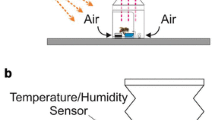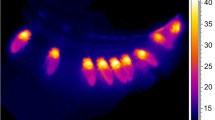Abstract
The thermal behavior of round and wagtail dancing honeybees (Apis mellifera carnica) gathering sucrose solutions of concentrations between 0.5 and 2 mol·l-1 was investigated under field conditions by infrared thermography (30–506 m flight distance). During the stay inside the hive thoracic surface temperature ranged from 31.4 to 43.9 °C. In both round and wagtail dancing honeybees the concentration of sucrose in the food influenced dancing temperature in a non-linear way. Average dancing temperature was 37.9 °C in foragers gathering a 0.5 mol·l-1 sucrose solution, 40.1°C with a 1 mol·l-1, 40.6°C with a 1.5 mol·l-1 and 40.7°C with a 2 mol·l-1 solution. The variability of thoracic temperature was highest with the 0.5 mol·l-1 and lowest with the 1.5 and 2 mol·l-1 concentrations. Thoracic temperatures during trophallactic contact with hive bees were similar to dancing temperature at 1.5 mol·l-1 but lower at the other concentrations. During periods of distribution of food to hive bees (trophallactic contact >2.5s) the dancers' thorax cooled down by more than 0.5°C considerably more frequently with the 0.5 mol·l-1 solution (65% of cases) than with the 1.5 mol·l-1 solution (26%). By contrast, heating the thorax up by more than 0.5°C was infrequent with the 0.5 mol·l-1 solution (2%) but occurred at a maximum rate of 26% with the 1.5 mol·l-1 solution. Bees gathering the 1 or 2 mol·l-1 solutions showed intermediate behavior. Linear model analysis showed that at higher concentrations the dancers compensated better for variations of hive air temperature: per 1 °C increase of hive temperature dancing temperature increased by 0.34, 0.22, 0.12, and 0.13 °C with 0.5, 1, 1.5, and 2 mol·l-1 sucrose solutions, respectively. The results furnish evidence that dancing honeybees follow a strategy of “selective heterothermy” by tuning their thermal behavior to the needs of the behavior performed at the moment. Thoracic temperature is regulated to a high level and more accurately when fast exploitation of profitable food sources is recommended. Thoracic temperature is lowered when the ratio of gain to costs of foraging becomes more unfavorable.
Similar content being viewed by others
Abbreviations
- SD :
-
standard deviation
- SD reg :
-
SD around regression line
- H rel :
-
relative humidity at feeding station
- T a :
-
air temperature at feeding station
- T i :
-
air temperature near the dancers
- T d :
-
Thoracic surface temperatures
- T d :
-
dancing
- T tr :
-
trophallactic contact (distribution of food)
- T w :
-
walking
- T stay :
-
mean temperature of total stay in the hive
References
Balderrama NM, Almeida de B LO, Núñez JA (1992) Metabolic rate during foraging in the honeybee. J Comp Physiol B 162:440–447
Brandstetter M, Crailsheim K, Heran H (1988) Provisioning of food in the honeybee before foraging. In: Nachtigall W (ed) BIONA-report 6, Akademie der Wissenschaften und Literatur zu Mainz: Gustav Fischer, Stuttgart New York, pp 129–148
Esch H (1960) Über die Körpertemperaturen und den Wärmehaushalt von Apis mellifica. Z Vergl Physiol 43:305–335
Esch H (1961) Über die Schallerzeugung beim Werbetanz der Honigbiene. Z Vergl Physiol 45:1–11
Esch H (1988) The effects of temperature on flight muscle potentials in honeybees and cuculiinid winter moths. J Exp Biol 135:109–117
Frisch K von (1935) Über den Geschmackssinn der Bienen. Z Vergl Physiol 21:1–157
Frisch K von (1965) Tanzsprache und Orientierung der Bienen. Springer, Berlin Heidelberg New York
Frisch K von, Lindauer M (1955) Über die Fluggeschwindigkeit der Bienen und über ihre Richtungsweisung bei Seitenwind. Naturwissenschaften 42:377–385
Goller F, Esch H (1991) Oxygen consumption and flight muscle activity during heating in workers and drones of Apis mellifera. J Comp Physiol B 161:61–67
Heran H (1952) Untersuchungen über den Temperatursinn der Honigbiene (Apis mellifera) unter besonderer Berücksichtigung der Wahrnehmung strahlender Wärme. Z Vergl Physiol 34:179–207
Kirchner WH, Lindauer M, Michelsen A (1988) Honeybee dance communication: acoustical indication of direction in round dances. Naturwissenschaften 75:629–630
Lacher V (1964) Elektrophysiologische Untersuchungen an einzelnen Rezeptoren für Geruch, Luftfeuchtigkeit und Temperatur auf den Antennen der Arbeitsbiene und der Drohne (Apis mellifica L.). Z Vergl Physiol 48:581–623
Lindauer M (1954) Temperaturregulierung und Wasserhaushalt im Bienenstaat. Z Vergl Physiol 36:391–432
Michelsen A (1993) The transfer of information in the dance language of honeybees: progress and problems. J Comp Physiol A 173:135–141
Michelsen A, Towne WF, Kirchner WH, Kryger P (1987) The acoustic near field of a dancing honeybee. J Comp Physiol A 161:633–643
Núñez JA (1966) Quantitative Beziehungen zwischen den Eigenschaften von Futterquellen und dem Verhalten von Sammelbienen. Z Vergl Physiol 53:142–164
Pflumm W (1969) Beziehungen zwischen Putzverhalten und Sammelbereitschaft bei der Honigbiene. Z Vergl Physiol 64:1–36
Schmaranzer S (1983) Thermovision bei trinkenden und tanzenden Honigbienen (Apis mellifera carnica). Verh Dtsch Zool Ges 76:319
Schmaranzer S (1984) Körpertemperaturmessungen mittels Thermovision bei Honigbienen während der Futtersuche und des Tanzes. In: Dirmhirn I, Bernhofer Ch (eds) International symposium in memory of Dr. Franz Sauberer. Universität für Bodenkultur, Wien, pp 51–53
Schmaranzer S (1990) Individuelle thermoregulatorische Fähigkeiten von Wasser sammelnden Honigbienen. Verh Dtsch Zool Ges 83:622–623
Schmaranzer S, Stabentheiner A (1988) Variability of the thermal behavior of honeybees on a feeding place. J Comp Physiol B 158:135–141
Schmaranzer S, Stabentheiner A (1991) Berührungslose Körpertemperaturmessung bei Insekten. Biologie in unserer Zeit 21:260–262
Schmaranzer S, Stabentheiner A, Heran H (1987) Thermografie bei Bienen. Film C 2046 of the ÖWF Wien: Österreichisches Bundesinstitut für den Wissenschaftlichen Film. Accompanying publication by Schmaranzer S, Stabentheiner A, Heran H (1988) in: Wiss Film 38/39: 64–68
Stabentheiner A (1991) Thermographic monitoring of the thermal behaviour of dancing bees. In: LJ Goodman, RC Fisher (eds) The behaviour and physiology of bees. CAB International, Wallingford UK, pp 89–101 and frontispiece
Stabentheiner A (1992) Entfernungsabhängigkeit der Thoraxtemperatur tanzender Honigbienen. Abstracts of the 13. Tagung der deutschsprachigen Sektion der Internationalen Union zum Studium Sozialer Insekten (IUSSI), pp 27
Stabentheiner A, Hagmüller K (1991) Sweet food means ‘hot dancing’ in honey bees. Naturwissenschaften 78:471–473
Stabentheiner A, Hagmüller K, Kovac H (1990) Thermisches Verhalten von Honigbienen im Schwänzeltanz. Verh Dtsch Zool Ges 83:624
Stabentheiner A, Schmaranzer S (1987) Thermographic determination of body temperatures in honey bees and hornets: calibration and applications. Thermology 2:563–572
Waddington K, Kirchner WH (1992) Acoustical and behavioral correlates of profitability of food sources in honey bee round dances. Ethology 92:1–6
Wenner AM (1962) Sound production during the waggle dance of the honey bee. Anim Behav 10:79–95
Author information
Authors and Affiliations
Additional information
Communicated by H. Langer
Rights and permissions
About this article
Cite this article
Stabentheiner, A., Kovac, H. & Hagmüller, K. Thermal behavior of round and wagtail dancing honeybees. J Comp Physiol B 165, 433–444 (1995). https://doi.org/10.1007/BF00261297
Accepted:
Issue Date:
DOI: https://doi.org/10.1007/BF00261297




